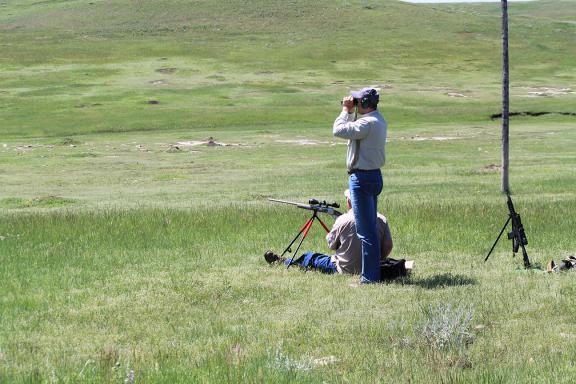
Prairie Dog Hunting
Prairie Dog Hunting in North Dakota: A sporting tradition that benefits land, rural communities and wildlife
Prairie dog hunting in North Dakota offers enthusiasts a unique and exhilarating experience deeply rooted in the state's vast and picturesque landscapes. The thrill of the hunt is matched only by the breathtaking beauty of the prairies, where expansive horizons stretch as far as the eye can see. As hunters set out across the rolling terrain, the discovery of vast prairie dog towns fills shooters with excitement. The crisp breeze carries the scent of wildflowers, while the distant calls of native birds add to the sense of adventure. Each successful shot is not just a triumph of skill but also a moment of connection with the land and its inhabitants. Whether enjoyed alone or shared with friends and family, prairie dog hunting in North Dakota is a celebration of nature's bounty and the joy of outdoor pursuits.
Prairie dog hunting in North Dakota requires careful planning and preparation to ensure a successful and enjoyable experience. Before setting out, hunters should familiarize themselves with state regulations and obtain the necessary licenses and permits. North Dakota residents do not need a license to take unprotected species of wildlife, including prairie dogs. Nonresidents only need a $15 nongame license. It's essential to choose appropriate gear, including a reliable rifle with sufficient range and accuracy for shooting at varying distances. Prairie dog hunting often sharpens shooting skill and helps gain greater accuracy in other hunting pursuits. Hunters should scout potential hunting locations beforehand, looking for areas with active prairie dog colonies and clear lines of sight. It is suggested that hunters make connections with landowners just as they would to hunt deer or pheasant. Many landowners welcome and embrace the sport to help control populations. Once in the field, the arrangement good shooting positions a few hundred yards from the prairie dog town with clear site lines from an elevated position are key. Selection of a good position can result in hours of shooting action.
Prairie dog hunting in North Dakota offers several benefits to rangeland ecosystems. By controlling prairie dog populations through regulated hunting, landowners and rangeland managers can help mitigate the impacts of overgrazing and habitat degradation. Wildlife ecosystems thrive in areas where prairie dog hunting is common. Scavengers and predators appreciate the easy forage and are less likely to rely on desirable game species for sustenance. Prairie dogs are prolific diggers, and their burrowing activities damage to crops and livestock grazing areas. By controlling populations, hunters support agricultural productivity and healthy rangeland. Sport hunting is by far the most ecological control method when compared to toxic poisons and gases. Furthermore, prairie dog hunting can generate revenue for conservation efforts and can reduce disease that comes with overpopulated prairie dog towns.
In North Dakota, prairie dog towns are found mostly west of the Missouri River in western and southwestern North Dakota. They are found in the greatest numbers in two primary ranges: the Little Missouri National Grasslands complex and the Standing Rock Complex. The Little Missouri Complex runs from McKenzie County on the Montana border east into Dunn County and south into all the way to the South Dakota state line. The Standing Rock complex begins on the west side of the Missouri River encompasses much of Sioux, Grant and Morton counties in far south-central North Dakota.
Prairie dog hunting plays a valuable role in preserving the ecological integrity and economic viability of North Dakota's rangelands. Prairie dog hunting remains a deeply ingrained tradition in North Dakota, reflecting the state's rich outdoor cultural heritage and strong connection to the land. Continued hunting can ensure that prairie dog hunting remains a cherished pastime for generations to come while benefiting agriculture and sustainable development and preservation of North Dakota's rural communities.

Landowners in these areas welcome prairie dog hunters as a way to control overpopulation.
Go to the Game and Fish Department website for more information.